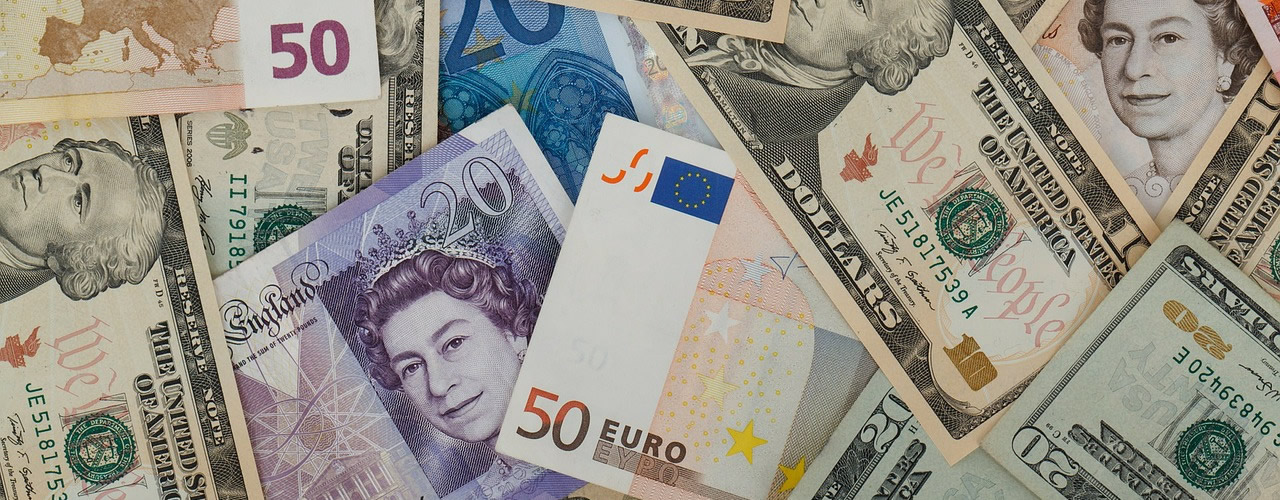How To Predict Currencies
How to make currency forecasts
Demand and supply are crucial for currency trends
In basic terms, the value of a currency or price is determined by supply and demand and this can be related to price changes in any other commodity such as copper or sugar.
A currency which has weak demand and high supply will tend to fall in value while a currency which has strong demand and low supply will tend to appreciate. When looking to make a currency forecast, these potential forces of supply and demand need to be examined in detail.
There is a complication in that commodities are bought and sold as an individual item. In contrast, for the vast majority of currency transactions, currencies have to be bought or sold against another currency and investors effectively therefore have to take a view on two currencies rather than one to determine the likely trend of a particular pair. The exception to this would be exchange traded funds.
Governments and central banks in an individual country have a strong influence on overall currency supply. They can, however, only aim to influence demand as they cannot directly control domestic or international demand for their currencies. Demand is influenced by a wide ranges of factors.
When making a forecast, it is necessary to assess the underlying risks on both sides of the equation to find the most likely outcome.
Reasons to hold a currency

There are two reasons to hold a currency; capital gain and yield
Shifts in monetary policy are extremely important for currency valuations, especially on a relatively short time frame. A tighter monetary policy tends to strengthen a currency as it reinforces expectations of both potential capital gain and improved yield.
Central bank policies are, therefore, extremely important for overall currency trends. When banks are tightening policy through higher interest rates, there is an improvement in yields which tends to support currencies as capital in drawn in to take advantage of yield.
In contrast, an easing of monetary policy will tend to undermine currencies as yields decline.
Relatives not absolutes are crucial
Values of currency pairs are determined by relative fundamentals
When looking at currency pairs, the key issue is one of relative qualities and not absolute qualities. This is particularly important when the global economy is in a strong growth phase or is in a recession. The fundamentals of all major countries could be very weak, but markets will still pick out relative winners and losers.
A country can have extremely poor fundamentals in absolute terms, but if country B is in an even worse position, the currency of country A will still tend to strengthen relative to currency B.
The valuation of currency pairs will, therefore, be influenced strongly by supply and demand issues in both individual countries.
Longer-term framework

Long-term currency trends tend to be entrenched
When looking at currency trends, it is important to look at the longer-term picture. This is especially important as it is easy to overly focus on short-term developments and miss the longer-term picture.
Currency values are also determined by the combination of fundamental flows and investment flows. Investment flows are increasingly important in currency markets, but trade fundamentals must not be ignored.
As well as looking at underlying valuations, it is also essential to look at long-term charts. Many currencies have a sustained long-term trend of appreciation or depreciation which can easily be sustained over decades. Powerful shifts in economic management are usually needed to reverse such a trend. There are of course big potential dividends if an investor can accurately spot such an important turning point.
Currency valuation
An estimate of ‘fair’ value gives important perspective
When looking at an individual currency, it is vital to have some basic understanding of a currency’s valuation relative to some estimate of fair value.
An analogy can be drawn with buying a house. If you are looking to buy a house in a certain street, a logical step is to look at the value of other houses in the same street to assess whether the house is reasonably valued.
Similar action need to be taken with currencies to gain some estimate of fair value. This is normally done through the concept of purchasing power parity (PPP). In other words, the cost of a certain common good should roughly cost the same amount in different countries.
The usual example is the ‘Big Mac’ index compiled by the Economist magazine. It looks at the cost of a standard McDonalds hamburger in different countries expressed in local currencies which then gives a theoretical appropriate value for the exchange rate between the two countries. This can then be compared with the actual exchange rate to make an estimate of whether a currency is over or undervalued. Some currencies can remain under or overvalued for an extended period, but a heavily overvalued currency is an important warning sign, especially if the fundamentals appear vulnerable. The OECD also publishes estimates of PPP values.
Inflation

Sustained high inflation weakens a currency
Over the longer-term, inflation and trade are the dominant influences in determining currency values.
If inflation rises strongly over the medium term, internal purchasing power will be eroded and downward pressure on the currency is inevitable. If an economy remains committed to low inflation, the currency will tend to strengthen over the medium term as internal purchasing power is maintained.
Over the longer term, the most important factor in determining currency forecasts will tend to be the inflation forecast. In turn, the most important factor in determining inflation forecasts is the structure and independence of central banks. In the majority of cases, a country with a strong and independent central bank will tend to have a strong currency while a politically-controlled central bank will tend to lead to a weak currency.
On a short-term view, higher inflation, associated with an overheating economy can be seen to be positive for a currency on expectations that the central bank will tighten policy.
Beware of deflation

Deflation is an unwelcome complication
Sometimes, an economy can be subjected to falling prices or deflation which needs to be treated very carefully given complex implications.
Falling prices in theory tend to support currencies as internal purchasing power strengthens. Deflation is, however, considered as very dangerous by government and central banks given fears that an economy will slide into depression. There are fears that falling prices will lead to consumers and companies postponing spending and investment decisions given expectations that prices will be cheaper over time, potentially leading to a downward spiral in activity.
Central banks, therefore, are therefore on high alert over deflation and will take aggressive action to reverse the trends. A crucial distinction, therefore, needs to be made between low inflation and negative inflation given the important differences.
Unorthodox monetary policies
Central banks have new weapons
As well as using interest rates to control economies, central banks have increasingly used quantitative easing or bond purchases. Under these policies, a bank creates money to buy bonds in the secondary market in order to lower bond yields and stimulate activity.
Quantitative easing, therefore, tends to put downward pressure on currencies due to lower yields and longer-term fears over devaluation polices. The act of expanding the central bank balance sheet also creates additional currency supply which is a negative factor.
Cyclical trends crucial
Currency values are also inherently cyclical in nature
For major economies there are also strong cyclical issues at play which will have important impacts on currencies. The most important element by far is the trend in central bank monetary polices.
Overlaid on long-term structural factors, there are also important cyclical currency trends. These tend to tie in with wider economic cycles of major economies. Looking at the long-term trends give an important perspective on potential ranges for pairs and the risks of appreciation or depreciation. Looking at GBP/USD for example, over the past 30 years, it has always struggled to sustain a move above 2.00 while there has been support below 1.35. There are no guarantees that trends will be sustained, but there are important implications for risk/reward.
It is also the case that currency trend tend to be self correcting which reinforces the cyclical element. A strong currency, for example, will tend to weaken the trade account which eventually puts fresh downward pressure on the currency.
Given the cyclical issues, there is a strong incentive to buy low and sell high.
Dollar and Federal Reserve dominance

A currency forecast will normally start with US interest rates
In terms of the global economy, the dollar is still the dominant reserve currency and the global monetary trends are still dominated by the US Federal Reserve.
When making any currency forecast, it is extremely important to forecast Federal Reserve policies as this will have a crucial impact on currency values even if the dollar is not directly being forecast.
Real yields are crucial
High real interest rates attract investors
Inflation trends also need to be watched very closely given their importance for the economy.
It is a similar situation to needing to look at relative economic performance rather than absolute performance when looking at currency pairs; An important distinction needs to be made between nominal and real yields. Nominal yields of 5% will be treated very differently if inflation is zero or 5%. If inflation is zero, real yields will be 5% and this will be much more supportive of a currency with little expectation of currency depreciation. If inflation is at 5%, real yields are effectively zero and there will be fears that the yield pick-up will be eroded by currency depreciation over time.
Any increase in interest rates to keep inflation under control is also a positive measure which boosts real yields.
Overall, therefore, real yields need to be watched very closely and not just nominal yields. On a short-term view, the most important determinant of currency values is the level of real interest rates.
Growth trends
Growth is a major factor in monetary policy
Markets also spend a lot of time fretting about growth rates and looking at a vast range of indicators to assess underling growth trends with the usual focus on overall GDP growth. This is not surprising as trends in growth will have a crucial impact on expectations surrounding potential currency appreciation and yield.
Strong growth will boost confidence in the outlook which will tend to boost capital inflows and there will also be expectations that central banks will tighten policy monetary policy, again boosting demand for the currency.
There is a strong incentive to buy currencies relatively early in a tightening cycle. It is therefore a strong potential buy signal when a central bank has been cutting rates to support an economy and then holds policy steady before looking to push rates higher. This is notably important if growth rates start to improve.
In contrast, investors should be looking to sell currencies when a bank has been tightening policy and looks to be at the point of ending the tightening, especially if there are recession fears.
Evidence of economic contraction is a very negative currency sign given fears of low interest rates and a deteriorating budget position.
Balance of payments
Current account deficits tend to weaken currencies
Another very important element is the balance of payments for individual countries.
A country running a substantial trade account deficit will have important vulnerability. Assuming that exports are invoiced in local currency and imports priced in overseas currencies, the act of running a trade deficit will mean that the country is pumping excess amounts of its own currency into the global economy. There is, therefore, an excess supply of that currency and, if overseas holdings are unwilling to hold the currency, there will need to be currency depreciation in order to tempt potential buyers on valuation grounds.
There is a temptation to focus on the narrow goods trade deficit, but the wider picture needs to be looked at as a country can have a substantial trade deficit which is offset by a large surplus on services or investment income
The overall current account situation is, therefore, the crucial element. A country running a substantial deficit will tend to have a weak currency
It is certainly possible to run deficits on a short-term basis, but a persistent deficit above 5% of GDP is an important warning sign.
An associated factor is rising overseas borrowing and higher external debt. An increase in external debt beyond sustainable levels around 50% is an extremely dangerous development given the risk that an economy will default which severely erodes confidence in the currency outlook.
Commodity producers/external shocks
Look at what a country exports
Some countries are very dependent on commodity exports, potentially with a very narrow base such as oil. These countries will be very vulnerable to a decline in commodity prices as the trade position will deteriorate rapidly.
An economy very dependent on oil exports will see strong currency gains when oil prices rise, but with major devaluation risks if oil prices decline.
Commodity currencies therefore tend to strengthen when the global economy strengthens and come under sustained pressure when there is a downturn in the global economy.
Central bank Intervention
Central banks look to influences currency rates
Governments and central banks remain very sensitive to currency levels. If a currency appears to be misaligned with fundamentals, there is the temptation to talk the currency up or down through verbal intervention.
There is also the potential for actual intervention whereby the central bank buys or sells currency in the open market to make a stronger statement that a currency is not aligned with fundamentals. Markets are often dismissive of such intervention and there is a natural temptation to take on central banks, although this is a very dangerous policy, especially if a currency is overvalued.
Currency pegs

Currency pegs are highly prone to failure which can trigger huge currency moves and extreme caution is required.
For a majority of currencies and economies, currencies are set by market forces with a floating exchange rate.
There are, however, also numerous important exception with currencies of pegged to other currencies. These can be long-term arrangements and relatively stable or a short-term arrangement to achieve stability.
Over the longer-term, currencies can only be successfully pegged if the fundamentals are broadly similar, especially in terms of price stability.
If there is long-term divergence between fundamentals, then the fixed-currency arrangement will come under serious stress. As these stresses build, measures will need to be taken to keep the peg intact. Predominantly, this will be in the form of intervention or higher interest rates.
It is also often the case that currency policies and intervention are in control of governments even if the policies are enacted through the central bank.
The act of intervening or changing interest rates often acts against the interests of the national economy. If for example, growth conditions are very weak, increasing fears that the currency is too strong, higher interest rates will act to further undermine confidence in the economy.
There is, therefore, a high risk that overall confidence in the economy will deteriorate further and this can quickly turn in to a cycle of deterioration. Levels of currency reserves will be watched very closely and a steady draining of reserves is a very important warning signs that the situation is unsustainable
In these circumstances, there is a high probability that the currency peg will break and will trigger a very substantial move in the currency once the peg is broken.
It is usually the case that governments and central banks try to defend an unsustainable strong exchange rate with a peg break pushing the currency sharply weaker.
There are, however, notable occasions when a central bank attempts to keep a currency weaker than justified by fundamentals. In these circumstances, the break will put strong upward pressure on the currency. These events are less likely, especially as it is easier to keep a currency too weak than too strong as there will be upward pressure on reserves rather than depletion.
The economic distortions can still be very important from a medium-term perspective.
The most notable example of this was the Swiss franc in 2015 when a decision to remove the Euro floor against the Swiss currency triggered very sharp upward pressure on the franc.
Confidence is crucial
Confidence, once lost, is difficult to regain
The fundamentals issue which needs to be looked at is that the decision to hold a currency is voluntary. Governments and central banks can try and stop capital flowing out of an economy and currency, but there is no way of forcing overseas investors to invest in an economy or currency.
In this context, confidence is crucial and essential. Anything which undermines confidence is a negative currency sign as there will tend to be weak currency demand and net capital outflows.
Political upheaval

Political stability is essential
Political stability is an important element in maintaining confidence. A period of instability and uncertainty surrounding economic policy is an important warning sign to international investors. This is particularly important when political change tends to undermine democracy and traditional democratic institutions.
In these circumstance, there will be fears that capital could become trapped in an economy and there will be the threat of substantial outflows which would put the currency under severe pressure.
A hostile attitude towards domestic capital also increases the risks that capital flows will increase and destabilise the local economy.
Any imposition of capital controls is a huge warning sign that currency instability is ahead.
Fiscal policy
Unfunded government spending is a big warning sign
Even if major political instability is avoided, a radical change of government and economic policies are always need to be watched very closely. In particular, fiscal policy is very important with spending and revenue very important.
A move to strongly increase government spending and put upward pressure on budget deficits is an important warning sign of increased medium-term instability, especially if debt/GDP ratios increase to well above 100%. The most important risk is associated with direct central bank financing of government deficits. This tends to be a harbinger of major inflationary pressures and currency devaluation. Even if direct financing is avoided, increased deficit financing undermines investor confidence.
The opposite situation is when a new and stronger government emerges after a period of instability. In these circumstances, there is the possibility of much stronger economic management and a reversal in overall economic fortunes. There is also the potential for a much stronger currency performance, especially if the currency is substantially undervalued.
It is something of a cliché but there is an important element of truth to the saying that markets hate uncertainty. In this context, a period of political instability tends to be a negative factor due to a lack of policy clarity. Currencies are also vulnerable ahead of an election or referendum where there are concerns over one particular outcome.
Credit rating changes
Solvency issues are very negative for a currency
The reputation of credit rating agencies has been severely undermined by their failure to forecast the 2008 financial crisis. Nevertheless, warnings over a sovereign downgrade with a negative outlook should be taken as a significant warning and the fundamentals need to be watched very closely.
In contrast, a rating shift to a positive outlook should be considered a potentially important positive sign.
Deterioration in the banking sector and rising bad debts is also a serious warning sign.
Speculative positioning
Beware of speculative excess
Non-commercial or speculative position taking is an extremely important element in modern currency markets. Each week, the Chicago Mercantile Exchange (CME) publishes details of non-commercial holdings in major currencies known as the Commitment of Traders (CoT) reports.
When currency trends take hold, there is an important risks that speculators will jump in to take advantage of a perceived trend and buy or sell it aggressively. Although this trend can continue in the short term, there is an important risk that positions will become over-extended. Institutional players are always very aware of speculative positions, and will look to take advantage of over-extended positioning by pushing the currency in the other direction and looking to trigger stop losses.
Aggressive positioning should, therefore, be treated with great caution given the risk of a sharp turnaround.
Discounting the future
Markets are forward looking
Markets are always looking to price in events before they happen. This lessens the impact of events as the moves have already been priced in. If, for example, a central bank monetary tightening is widely expected, markets will move to strengthen a currency before the decision is taken. This will lessen the potential for a further reaction when the decision is actually taken.
Warning signs
- These are key warning signs that warn of a probably weakening currency trend
- A sustained current deficit of over 5% of GDP
- External debt in excess of 50% of GDP
- Government debt above 125% of GDP
- An economy sliding towards recession
- An erosion of central bank independence
- Central banks pushing the currency weaker
- Central banks starting an easing cycle.
- A downturn in the global economy for commodity currencies
- Intervention is needed to sustain a currency peg
Encouraging signs
- A falling current account deficit
- A political move to strengthen central bank independence
- A strengthening economy built on investment
- A central bank engaging in a tightening monetary policy cycle
- Central banks are intervening to prevent currency gains
Summary
Over the longer term, the most important elements in currency forecasts are inflation, trade and underlying currency trends. High inflation and weak trade positions will make a currency weaken while low inflation and trade strength will lead to appreciation.
On a shorter-term horizon, the most important element by far is the level and changes in real interest rates and yields. Trends in the Federal Reserve policies are extremely important for global currency markets.
Strengthening growth and higher interest rates will tend to support a currency while weakening growth and lower interest rates will tend to weaken a currency.
Three steps to making a forecast
- Look at longer-term trends to assess valuation and potential trends
- Look for any clear fundamental warning signs
- Look to assess whether demand is likely to be stronger or weaker than supply
- Look at likely trends in growth and interest rates


